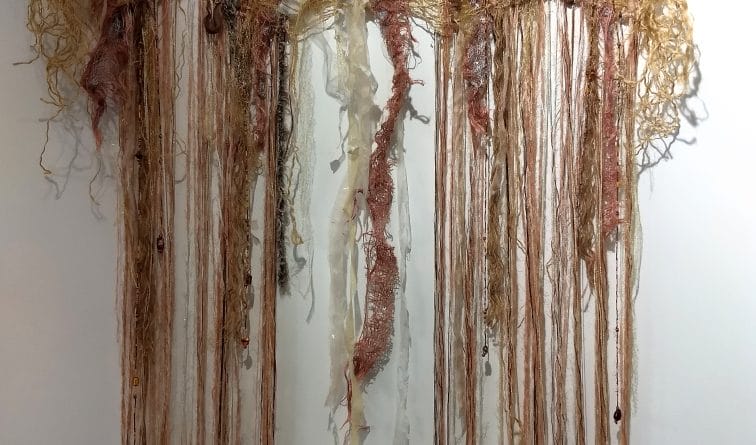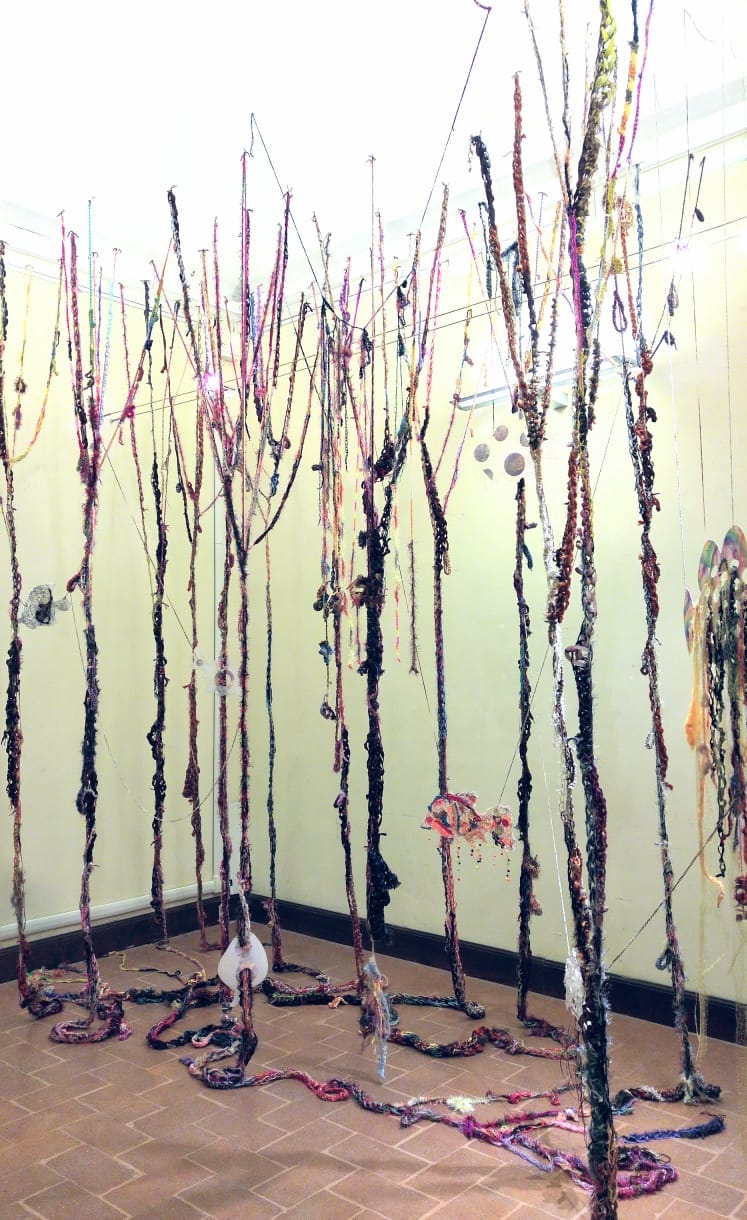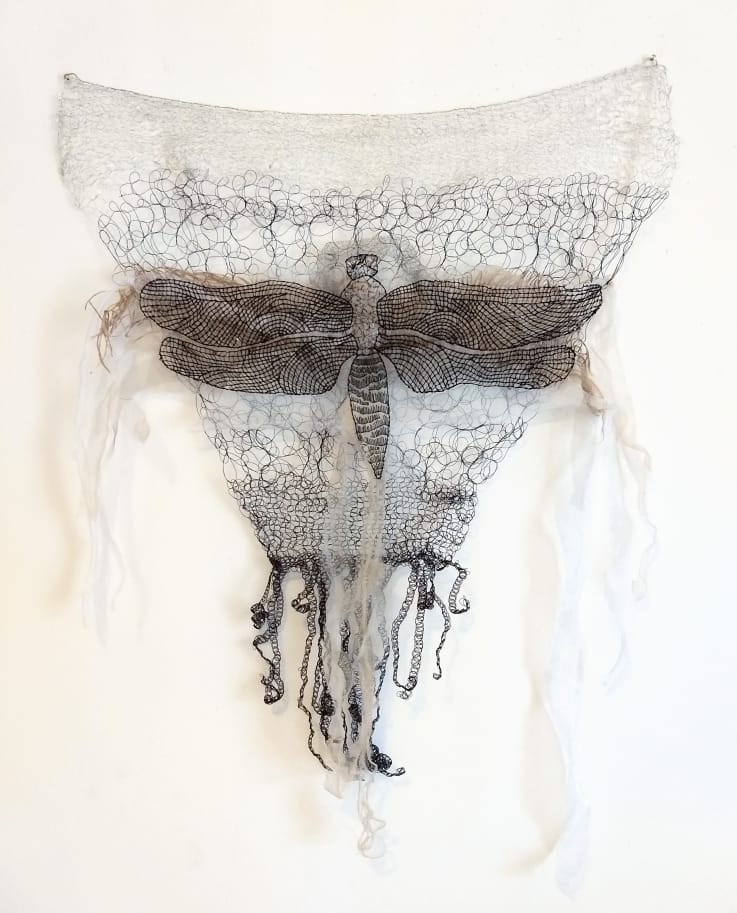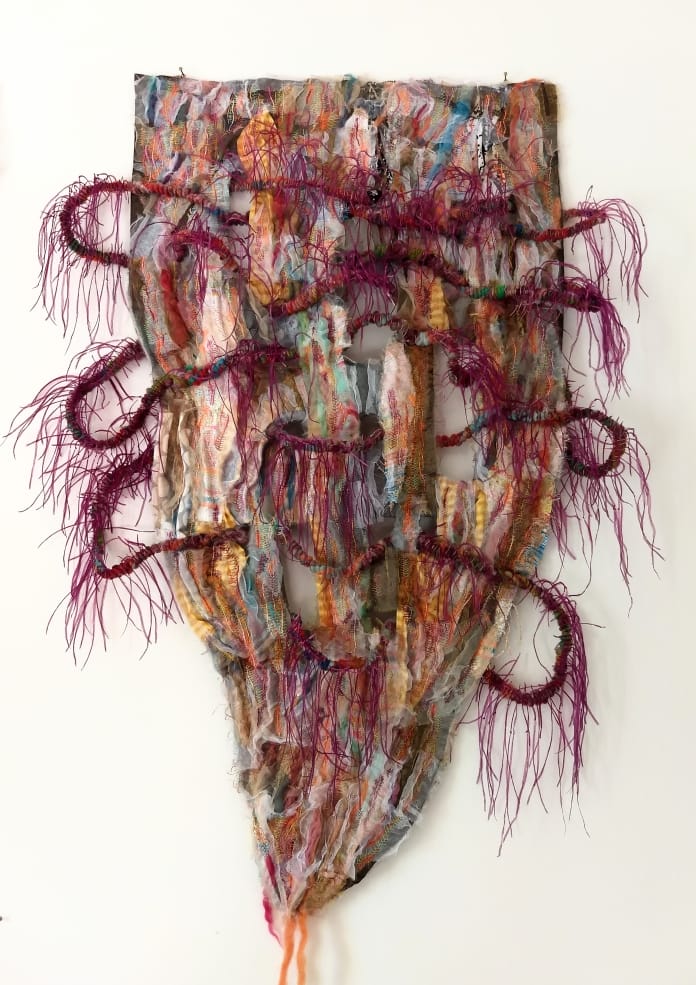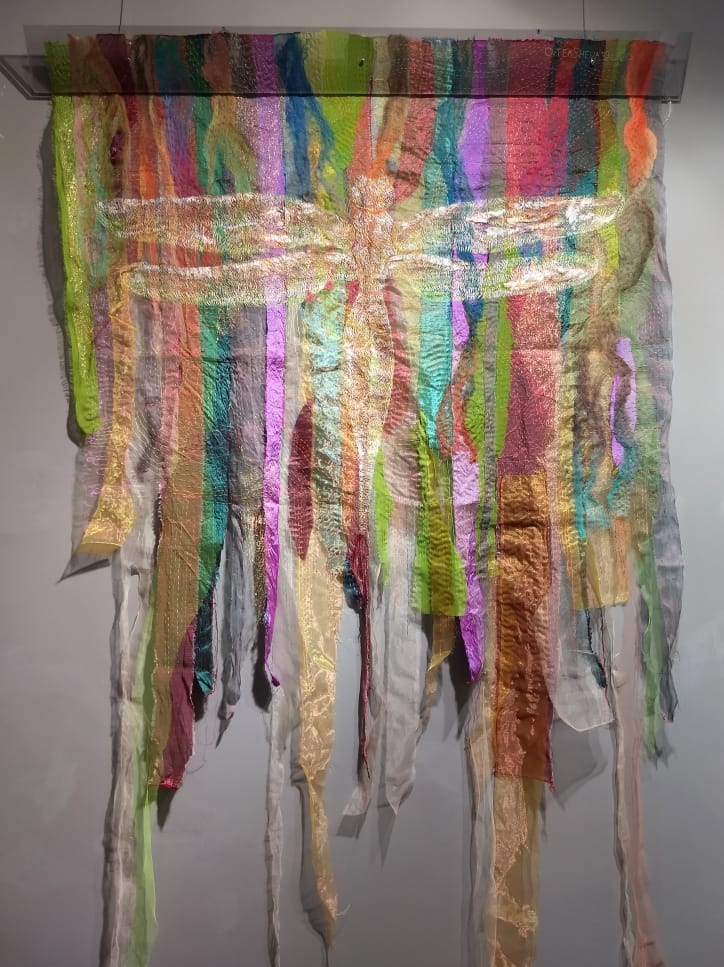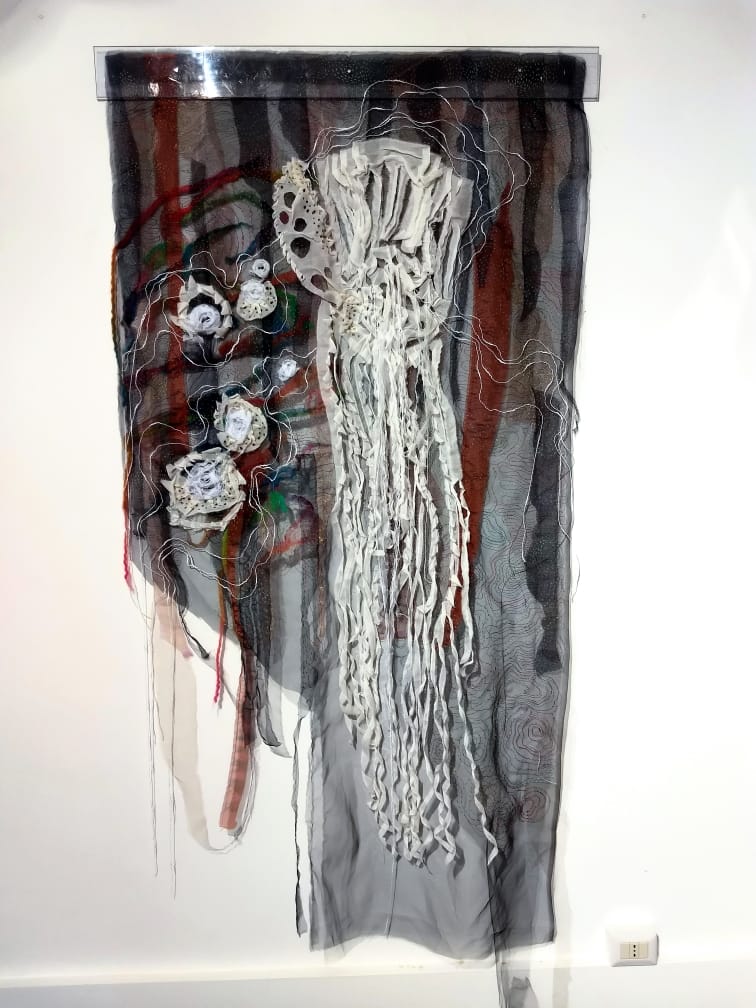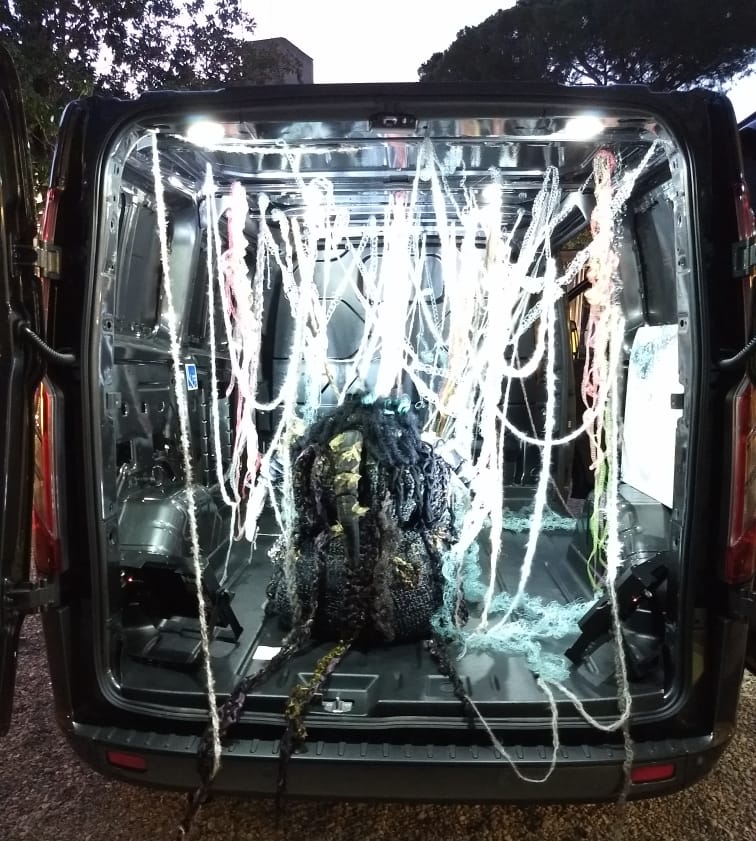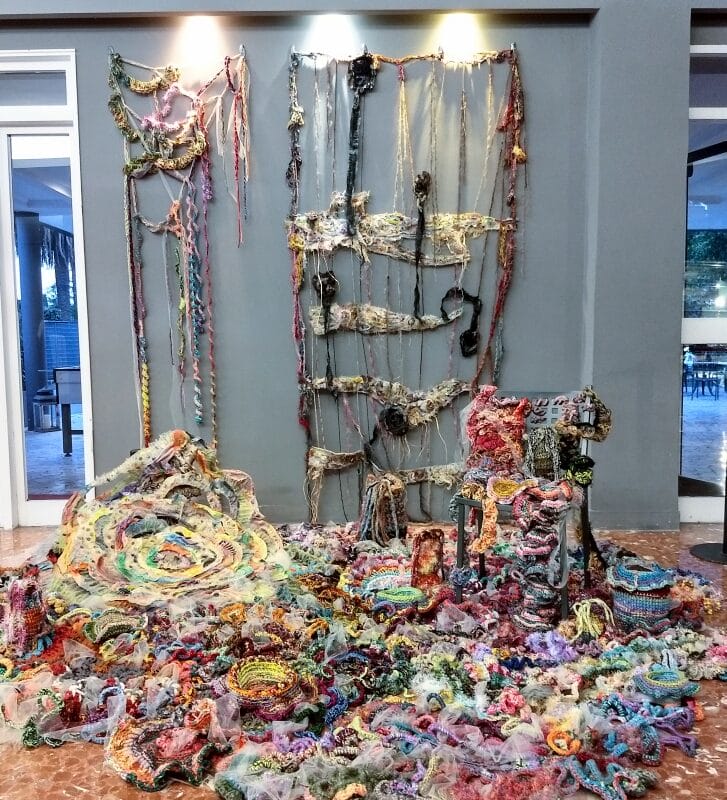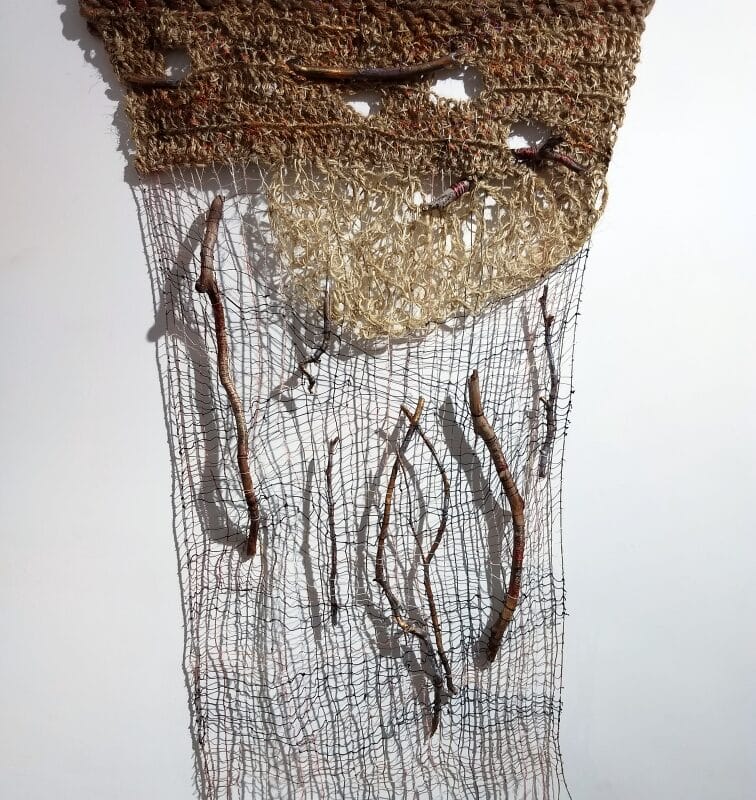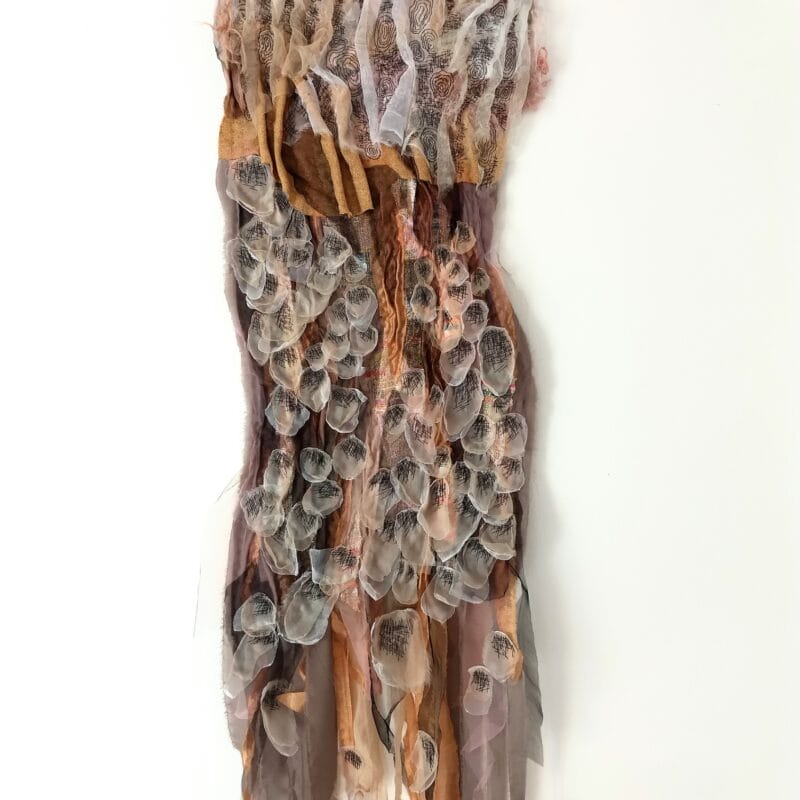Interview with Olga Teksheva
Translation by Marina Dlacic
Born in Moscow, class of 1973, Roman by adoption, Olga Teksheva is a textile artist who draws on a multi-ethnic and cosmopolitan cultural and personal background to create sculptures and installations with a complex narrative. Her are ‘layered’ works in which textile collages, embroideries, crocheted elements, hand-woven interventions alternate and aim to establish an immersive and tactile relationship with the user, transforming the space around him/her.
Olga Teksheva ph.credit Velia Littera
A long journey through fashion, communication, art to arrive at Fiber Art: can you tell us about the path that led to fibers and fabrics in your artistic research?
First of all, I would say“art” rather than “fiber art” or “textile art”. The precise definitions seem a bit limiting to me. I am a contemporary artist who uses fabrics and fibers as a means of expression, I sculpt with fabrics. From an early age I was passionate about fabrics, I collected the small pieces of fabrics that my grandmother and my mother sewed clothes with and I made “compositions” on the floor, real textile installations, even if at the age of four I didn’t know anything about installations!
I dreamed of becoming a stylist or dealing with prints on fabrics. Unfortunately it wasn’t possible as I graduated in 1990 when my country was collapsing. Everything was missing: food, clothes, security in the future above all. Under the pressure of the family, I chose a “safer” path by enrolling at the Lomonosov University of Moscow, in the Faculty of Art History. This path would have allowed me to work as an art critic, as a journalist, as a teacher …In the first year of my studies, I began to be an assistant to the Russian textile artist Natalia Muradova, learning to sculpt with fabrics, to make batik, to weave. I think it was a decisive experience for me. In the third year I started collaborating with a newspaper, the “Nezavisimaia Gazzetta” for their section dedicated to fashion. I chose “History of the costume of the Kabuki theater” as my degree thesis and from that choice my boundless love for Japanese art and culture was born, another fundamental influence for my artistic career today.
I proceeded with my career in fashion, collaborating with the magazines “L’Officiel” and “Collezioni” in Russian, teaching History of Costume, History of Fashion and Contemporary Art to students of the Fashion Design faculty of the National Institute of Design in Moscow. But I couldn’t find “myself”, I had the feeling of living the life of another person. To “do something for the real me” I started attending the drawing and painting course at the Studio Ludmila Ermolaeva, another decisive event. I was lucky to meet a wonderful teacher, full of creativity and with an individual approach for each student. Above all, as passionate about fabrics as I am!
In 2008 I decided to take a couple of “sabbatical” years and came to Rome to take a course in Fashion design at the Academy of Costume and Fashion. Designing the collections as a stylist, I realized that the only thing that interested me was working with fabrics, draping, experimenting with surfaces, learning high fashion embroidery. Even my final collection looked like a series of sculptures in shantung silk, and in fact in 2011 I was invited to show it as part of the Feudi di San Marzano Contemporary Art Festival.
After the birth of my daughter I completely abandoned my career as a journalist and I decided to dare the artistic one as I have always dreamed of. In 2015, the first experiments with contemporary embroidery arrived (it was not easy to give up the high fashion embroidery base, but I wanted to revisit and overturn everything!). In 2017 I set up my first solo show, “Once upon a time there was a fish sitting on a tree”, at Villino Corsini in Villa Pamphilj in Rome; just for that project I made my first installation with large fibers. From that moment there was no going back, I was completely immersed in designing, experimenting, producing works of art with fabrics and fibers.
“Once upon a time there was a fish sitting on a tree”, cm.450x500x250, Villino Corsini Villa Pamphilj, Rome, 2017
There is a fantastic, almost magical figure in your work; what are its roots and what are your sources of inspiration?
Nature is the strongest source of inspiration; each new series of textile works begins with graphic research, studies of the surfaces of natural objects – the patterns on pebbles, the bark of trees, the “skeleton” of a leaf found on the street, shells …”signs”which are then introduced as embroidery stitches. In my opinion, there is no more fantastic, more magical source than nature.
This love, almost a religious adoration for the natural world, has its roots in my childhood. During summer I used to go to the village of origin of my paternal grandparents which is located in the boundless steppes in the south of Russia, a territory with a great history, where for centuries the great empires of the peoples of the steppes existed and, even in the twentieth century, you could experience traditional shamanistic cultures. My grandmother’s sister practiced traditional medicine based on herbs and magical songs. She was a person who had a very deep relationship with nature.I still remember how every morning, leaving the house, she would greet the sky, the sun, spoke with the plants and the animals in her garden. This relationship of love and friendship with nature has influenced me a lot. Some works become almost “totems”, magical objects with their own will and vital energy. In fact, when I’m working, I often talk to my fabrics to persuade them to help me … fabrics are a difficult material, with their character, they don’t easily obey the artist!
The other source of “magical inspiration” is very different from the world of traditional beliefs. In fact, I have always loved the art of the Italian Renaissance. My mother has a large library dedicated to Renaissance artists and as a child I used to leaf through those books for hours and hours, admiring the landscapes and fantastic faces of Sandro Botticelli, Beato Angelico, Cosmè Tura, Andrea Mantegna … Those paintings made me dream of something greater, more important than everyday reality, and this feeling of “flying beyond” is fundamental to everything I do as an artist.
“Dragonfly” series, “Birth of Flight”, 2020, cm.70×130, hand embroidery on fabric collage, crochet fishing line and metal thread
What is the relationship between content and form in your works?
It is not an obvious relationship. Many works have a real genesis in my mind before being made. It always starts from the emotions, sensations, thoughts that I find in the history and archeology books that are important for my research. Although my works are abstract (almost always), behind there is an interest in how the human mind works, in how hopes and dreams are born. Studying history and archeology from the point of view of the evolution of the human mind gives birth to the content of my works.
Often the thoughts that are the basis of a series of textile works do not have a “direct” expression in the form. For example, the “Rocks. We Are Tender “on which I am working in this period is inspired by the experiences lived in the period of lockdown, by stories of fear and hope, of tiredness and resistance that I have heard from my friends in Italy, in Russia, in Switzerland, in England; they are stories of fragility, weakness and enormous strength at the same time. As if people had become rocks that are able to withstand many challenges, but at the same time fragile and vulnerable. The idea of ”rocks” led to research the surface of stones and pebbles, rich in particular patterns that in the art works become embroideries on many layers of textile collages.
As I proceeded with the graphic research thinking about the series, other themes relevant to the “people-rocks” emerged: house, identity, freedom. So this series as a content is becoming something much broader than I thought at the beginning, while the materials and forms always remain consistent with the first work of the series.
Series “Rocks. We Are Tender”, “When Rocks Grow Feathers They Learn to Fly”, 2021, cm.80×135, felt base, hand embroidery on a collage of fabrics and eco-leather, weaving with wool rope, vintage feathers by marabou
How do you choose the materials you use for your works?
Wherever I happen to travel, I look for particular fabrics and materials. My friends give me small pieces of antique lace, buttons, necklaces with original elements, vintage feathers, balls of wool; I often think about how much patience my husband and my daughter must have to live with this whole collection! Every so often it happens to find a real “treasure island”. Shortly before the lockdown, my fabric supplier let me know that a historic high fashion atelier had closed in via Veneto in Rome and that there were several scraps of fabrics left that he was unable to sell to his customers who did not appreciate “the old stuff “. I took it all: they are wonderful fabrics, all of them of Italian production from the 80s-90s. I took them not only for the quality of workmanship and for the wonderful colors, but also because it seemed a sacrilege to throw away a piece of Italian fashion history. Slowly they will take on new life in my works.
“Dragonfly” series, “Birth of Color”, 2020, cm.128×160 / 230, plexiglass supporting structure, hand embroidery on fabric collage
You are Russian by birth, Italian by adoption, you have studied the Japanese language and culture for a long time; how much and how does this richness of contamination influence your work?
I was born and raised in a family where six different ethnic groups and four religious traditions are represented. Sometimes it could drive you crazy also because not even you yourself could “frame” who you were! I wonder how these people, so different from each other, have managed to create such a close and loving family. In my works I “marry” all the possible materials, the contemporary ones with the vintage ones, I mix different techniques: embroidery, weaving, beading, working with feathers, I include “found objects”. So each of my works is also a mixed family!
At the age of 16 I received my first passport and in the application form it was also necessary to indicate the ethnicity (in Russia there are more than 120!): I looked at the policeman perplexed and confused, then I told him the list of all the ethnic groups of the family. He thought about it for a while and then asked me “In which language did you say your first word? In what language did you say “mom?”I replied “In Russian! But my first word wasn’t “mom” it was dog and the second suitcase”. The policeman kept staring at me, then decided to write “Russian” not without pointing out that I was a really strange girl and predicting while I was leaving the office that I would become an artist when I grew up … This story still makes me smile today!
Navigating through different realities was fundamental. With my grandparents I learned to live according to absolutely different lifestyles, different cuisines, different standards of behavior. At my maternal grandmother, a Polish aristocrat, I wore dresses with bows and flowers, ate with a fork and knife, I was combed so perfectly that even if they had put me near the propeller of a helicopter, my hair would have remained perfectly styled. At my paternal grandparents I ran barefoot with shorts amongst other free children, sometimes we went off into the “open steppe” to stroke the wild horses (I still wonder how we survived that experience!). At my parents’ house I spent hours reading books on the art and culture of the Italian Renaissance, but at the university I chose Japan, leaving my parents shocked. I wanted to break away from everything I knew, to study a profoundly different artistic mentality.
All these worlds experienced in first person have greatly influenced my way of thinking and working. From my perfectionist grandmother I got the mania that everything must be done perfectly. A textile work of art must be created like a high fashion dress. Each embroidery stitch flawless. The materials rare and precious. From the freedom of the steppes I got into the habit of treating my materials as if they were living things, leaving them free to change my initial idea, as if the fabrics were those wild horses that remain in my heart even today. From the beloved Renaissance I have learned to treat a work of art as a precious, unique object that expresses a magical world, a better world. From Japan I took everything as an artist: the colors, the “living” surfaces, the motifs, the patterns. Studies in Japan have profoundly changed me as a person and as an artist. Even today, despite a lot of time spent with my works, I dedicate 30 minutes every day to the Japanese language to keep that bond strong.
Series “Material / Immaterial”, “Listening to a Butterfly’s Wings”, 2020, cm.122×240, plexiglas supporting structure, hand embroidery on fabric collage
Yours are essentially three-dimensional works – from wall-sculptures to large installations: what relationship is there between the work and the space that hosts it?
Fabric as a material invites us to think in a three-dimensional way: our experience of contact with fabrics often refers to the clothes that surround us, pamper us, cover our fragility. The love for the “draping” or “moulage” technique that is used in high fashion to create an evening dress and then to develop the pattern at the base of the drapery made itself felt right from the earliest works of textile art.
Then we added the threads and the pieces of rope that emerge from the surface, the crochet elements that add volume, the found objects such as branches or large pieces of tree bark. With these materials, the work is already detached from the wall, even if the artist had no intention of doing it from the beginning.
And then, from my first solo show, I worked on fiber installations, made from crocheted elements to create a real theatrical scenography that invites the viewer to interact. The results are not always predictable, but they always make me cheer. For example, at Art Rooms Rome 2019, when I made an installation inspired by the sacred forest of the Janiculum in fishing line in a van and a child slipped inside the van and began to move the “trees” and sing, and tell them fairy tales! The parents were terrified, but I asked them to let him experience his moment of enchanted space.It was not the only case. I saw a gentleman who slowly put his arm inside the installation and then retracted it because he imagined the installation as a portal to a parallel reality and so he imagined that putting his arm in there something would happen. He felt strongly that that work was there to change the perception of space, to make it magical, to feel like a child again.
I think that all my works are created for this, to interact with space, to make it magical, a world to be discovered. For me it is very important that people interact with my objects, touch them. Once a spectator came up to ask “Can I CARESS the sculpture, please?” The verb “caress” that he used as if it were a living creature is perfect for the inhabitants of the magical world I am trying to create.
Series “Appearing / Disappearing”, 2019, trees in crocheted fishing line, the textile sculpture “Fiore Fossile II”, a special project for Ford Italia at Art Rooms Rome 2019
What are you working on in this period and what projects do you have in your drawer for the future?
In the last days of 2020, as I mentioned, I started a new series, “Rocks. We Are Tender ”, inspired by the experiences of my loved ones in this difficult year. The theme of rocks led me to graphically research the surface of the rocks in different regions of Italy: Molise, Abruzzo, Tuscany, Lazio.
While I was working with the first work of the series, I happened to read the book of a fantastic Russian archaeologist, Andrei Nikitin in which he tells that 10 – 12 thousand years ago people understood as “home” the vast forest spaces, in the plains or in the mountains, which they traveled on foot all year round. The house was a boundless space.The experience of having lived for three months closed inside four walls and then from one day to the next go trekking in the mountains where I collected the materials for the new works made me reflect a lot on shutdown and safety, on freedom of movement. , about the wild and almost hostile nature that our ancestors once considered home.
The next series will be inspired by the book “Forbidden Archeology”. I was struck by the observation that often, studying the most ancient artifacts, scientists are unable to establish whether the marks on the stone surface are of natural or artificial origin, whether they are the result of geological phenomena or the will of human beings. This idea seems fantastic to me, at the moment I’m working on it. Let’s see what will come from it!
